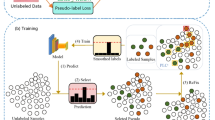Abstract
Computer-aided diagnosis via deep learning relies on large-scale annotated data sets, which can be costly when involving expert knowledge. Semi-supervised learning (SSL) mitigates this challenge by leveraging unlabeled data. One effective SSL approach is to regularize the local smoothness of neural functions via perturbations around single data points. In this work, we argue that regularizing the global smoothness of neural functions by filling the void in between data points can further improve SSL. We present a novel SSL approach that trains the neural network on linear mixing of labeled and unlabeled data, at both the input and latent space in order to regularize different portions of the network. We evaluated the presented model on two distinct medical image data sets for semi-supervised classification of thoracic disease and skin lesion, demonstrating its improved performance over SSL with local perturbations and SSL with global mixing but at the input space only. Our code is available at https://github.com/Prasanna1991/LatentMixing.
Access this chapter
Tax calculation will be finalised at checkout
Purchases are for personal use only
Similar content being viewed by others
References
Berthelot, D., Carlini, N., Goodfellow, I., Papernot, N., Oliver, A., Raffel, C.A.: Mixmatch: a holistic approach to semi-supervised learning. In: Advances in Neural Information Processing Systems, pp. 5050–5060 (2019)
Bortsova, G., Dubost, F., Hogeweg, L., Katramados, I., de Bruijne, M.: Semi-supervised medical image segmentation via learning consistency under transformations. In: Shen, D., et al. (eds.) MICCAI 2019. LNCS, vol. 11769, pp. 810–818. Springer, Cham (2019). https://doi.org/10.1007/978-3-030-32226-7_90
Codella, N., et al.: Skin lesion analysis toward melanoma detection 2018: a challenge hosted by the international skin imaging collaboration (isic). arXiv preprint arXiv:1902.03368 (2019)
Gyawali, P.K., Li, Z., Ghimire, S., Wang, L.: Semi-supervised learning by disentangling and self-ensembling over stochastic latent space. In: Shen, D., et al. (eds.) MICCAI 2019. LNCS, vol. 11769, pp. 766–774. Springer, Cham (2019). https://doi.org/10.1007/978-3-030-32226-7_85
Irvin, J., et al.: Chexpert: a large chest radiograph dataset with uncertainty labels and expert comparison. In: AAAI (2019)
Laine, S., Aila, T.: Temporal ensembling for semi-supervised learning. In: ICLR (2017)
Luo, Y., Zhu, J., Li, M., Ren, Y., Zhang, B.: Smooth neighbors on teacher graphs for semi-supervised learning. In: Proceedings of the IEEE Conference on Computer Vision and Pattern Recognition, pp. 8896–8905 (2018)
Miyato, T., Maeda, S.I., Koyama, M., Ishii, S.: Virtual adversarial training: a regularization method for supervised and semi-supervised learning. IEEE Trans. Pattern Anal. Mach. Intell. 41(8), 1979–1993 (2018)
Peng, J., Estrada, G., Pedersoli, M., Desrosiers, C.: Deep co-training for semi-supervised image segmentation. Pattern Recogn. 107, 107269 (2020)
Tschandl, P., Rosendahl, C., Kittler, H.: The ham10000 dataset, a large collection of multi-source dermatoscopic images of common pigmented skin lesions. Sci. Data 5, 180161 (2018)
Verma, V., et al.: Manifold mixup: better representations by interpolating hidden states. In: International Conference on Machine Learning, pp. 6438–6447 (2019)
Zhang, H., Cisse, M., Dauphin, Y.N., Lopez-Paz, D.: Mixup: beyond empirical risk minimization. arXiv preprint arXiv:1710.09412 (2017)
Acknowledgement
This work is supported by NSF CAREER ACI-1350374 and NIH NHLBI R15HL140500.
Author information
Authors and Affiliations
Corresponding author
Editor information
Editors and Affiliations
Rights and permissions
Copyright information
© 2020 Springer Nature Switzerland AG
About this paper
Cite this paper
Gyawali, P.K., Ghimire, S., Bajracharya, P., Li, Z., Wang, L. (2020). Semi-supervised Medical Image Classification with Global Latent Mixing. In: Martel, A.L., et al. Medical Image Computing and Computer Assisted Intervention – MICCAI 2020. MICCAI 2020. Lecture Notes in Computer Science(), vol 12261. Springer, Cham. https://doi.org/10.1007/978-3-030-59710-8_59
Download citation
DOI: https://doi.org/10.1007/978-3-030-59710-8_59
Published:
Publisher Name: Springer, Cham
Print ISBN: 978-3-030-59709-2
Online ISBN: 978-3-030-59710-8
eBook Packages: Computer ScienceComputer Science (R0)





